Related Research Articles

The history of Mexico spans more than three millennia, beginning with the early settlement over 13,000 years ago. Central and southern Mexico, known as Mesoamerica, saw the rise of complex civilizations that developed glyphic writing systems, recording political histories and conquests. The Spanish conquest of the Aztec Empire in the early 16th century established New Spain, bringing Spanish rule, Christianity, and European influences.
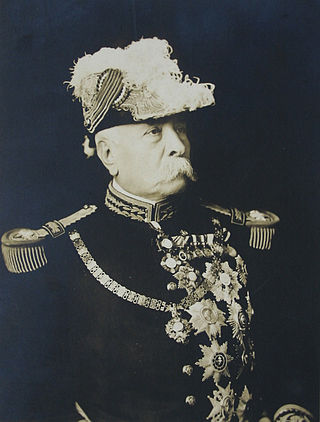
José de la Cruz Porfirio Díaz Mori, known as Porfirio Díaz, was a Mexican general, politician, and dictator who served on three separate occasions as President of Mexico, a total of over 30 years, from 28 November 1876 to 6 December 1876, 17 February 1877 to 1 December 1880, and 1 December 1884 to 25 May 1911. The entire period from 1876 to 1911 is often referred to as the Porfiriato, and has been characterized as a de facto dictatorship.

Benito Pablo Juárez García was a Mexican politician, military commander, and lawyer who served as the 26th president of Mexico from 1858 until his death in office in 1872. Of Zapotec ancestry, he was the first indigenous president of Mexico and the first democratically elected indigenous president in the postcolonial Americas. A member of the Liberal Party, he previously held a number of offices, including the governorship of Oaxaca and the presidency of the Supreme Court. During his presidency, he led the Liberals to victory in the Reform War and in the Second French intervention in Mexico.

José Venustiano Carranza de la Garza, known as Venustiano Carranza, was a Mexican land owner and politician who served as President of Mexico from 1917 until his assassination in 1920, during the Mexican Revolution. He was previously Mexico's de facto head of state as Primer Jefe of the Constitutionalist faction from 1914 to 1917, and previously served as a senator and governor for Coahuila. He played the leading role in drafting the Constitution of 1917 and maintained Mexican neutrality in World War I.
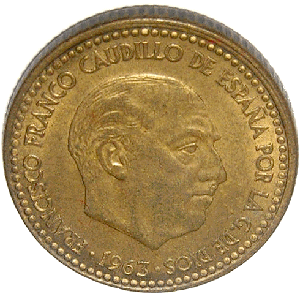
A caudillo is a type of personalist leader wielding military and political power. There is no precise English translation for the term, though it is often used interchangeably with "military dictator," "warlord" and "strongman". The term is historically associated with Spain and Hispanic America, after virtually all of the regions in the latter won independence in the early nineteenth century.
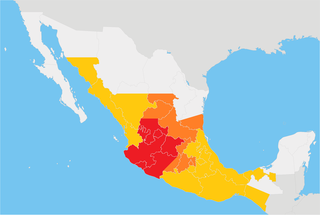
The Cristero War, also known as the Cristero Rebellion or La cristiada, was a widespread struggle in central and western Mexico from 3 August 1926 to 21 June 1929 in response to the implementation of secularist and anticlerical articles of the 1917 Constitution. The rebellion was instigated as a response to an executive decree by Mexican President Plutarco Elías Calles to strictly enforce Article 130 of the Constitution, a decision known as the Calles Law. Calles sought to limit the power of the Catholic Church in Mexico, its affiliated organizations and to suppress popular religiosity.

Liberalism in Mexico was part of a broader nineteenth-century political trend affecting Western Europe and the Americas, including the United States, that challenged entrenched power. In Mexico, liberalism sought to make fundamental the equality of individuals before the law, rather than their benefiting from special privileges of corporate entities, especially the Roman Catholic Church, the military, and indigenous communities. Liberalism viewed universal, free, secular education as the means to transform Mexico's citizenry. Early nineteenth-century liberals promoted the idea of economic development in the overwhelmingly rural country where much land was owned by the Catholic Church and held in common by indigenous communities to create a large class of yeoman farmers. Liberals passed a series of individual Reform laws and then wrote a new constitution in 1857 to give full force to the changes. Liberalism in Mexico "was not only a political philosophy of republicanism but a package including democratic social values, free enterprise, a legal bundle of civil rights to protect individualism, and a group consciousness of nationalism." Mexican liberalism is most closely associated with anticlericalism. Mexican liberals looked to the U.S. as their model for development and actively sought the support of the U.S., while Mexican conservatives looked to Europe.

Juan Nepomuceno Álvarez Hurtado de Luna, generally known as Juan Álvarez, was a general, long-time caudillo in southern Mexico, and president of Mexico for two months in 1855, following the liberals' ouster of Antonio López de Santa Anna. His presidency inaugurated the pivotal era of La Reforma.

In the history of Mexico, La Reforma, or reform laws, refers to a pivotal set of laws, including a new constitution, that were enacted in the Second Federal Republic of Mexico during the 1850s after the Plan of Ayutla overthrew the dictatorship of Santa Anna. They were intended as modernizing measures: social, political, and economic, aimed at undermining the traditional power of the Catholic Church and the army. The reforms sought separation of church and state, equality before the law, and economic development. These anticlerical laws were enacted in the Second Mexican Republic between 1855 and 1863, during the governments of Juan Álvarez, Ignacio Comonfort and Benito Juárez. The laws also limited the ability of Catholic Church and indigenous communities from collectively holding land. The liberal government sought the revenues from the disentailment of church property, which could fund the civil war against Mexican conservatives and to broaden the base of property ownership in Mexico and encouraging private enterprise. Several of them were raised to constitutional status by the constituent Congress that drafted the liberal Constitution of 1857. Although the laws had a major impact on the Catholic Church in Mexico, liberal proponents were not opposed to the church as a spiritual institution, but rather sought a secular state and a society not dominated by religion.
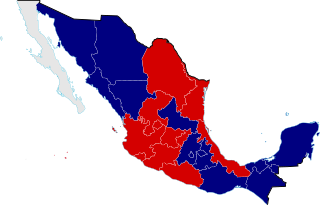
The Reform War, or War of Reform, also known as the Three Years' War, and the Mexican Civil War, was a complex civil conflict in Mexico fought between Mexican liberals and conservatives with regional variations over the promulgation of Constitution of 1857. It has been called the "worst civil war to hit Mexico between the War of Independence of 1810-21 and the Revolution of 1910-20." Following the liberals' overthrow of the dictatorship of conservative Antonio López de Santa Anna, liberals passed a series of laws codifying their political program. These laws were incorporated into the new constitution. It aimed to limit the political power of the executive branch, as well as the political, economic, and cultural power of the Catholic Church. Specific measures were the expropriation of Church property; separation of church and state; reduction of the power of the Mexican Army by elimination of their special privileges; strengthening the secular state through public education; and measures to develop the nation economically.

The military history of Mexico encompasses armed conflicts within that nation's territory, dating from before the arrival of Europeans in 1519 to the present era. Mexican military history is replete with small-scale revolts, foreign invasions, civil wars, indigenous uprisings, and coups d'état by disgruntled military leaders. Mexico's colonial-era military was not established until the eighteenth century. After the Spanish conquest of the Aztec Empire in the early sixteenth century, the Spanish crown did not establish on a standing military, but the crown responded to the external threat of a British invasion by creating a standing military for the first time following the Seven Years' War (1756–63). The regular army units and militias had a short history when in the early 19th century, the unstable situation in Spain with the Napoleonic invasion gave rise to an insurgency for independence, propelled by militarily untrained men fighting for the independence of Mexico. The Mexican War of Independence (1810–21) saw royalist and insurgent armies battling to a stalemate in 1820. That stalemate ended with the royalist military officer turned insurgent, Agustín de Iturbide persuading the guerrilla leader of the insurgency, Vicente Guerrero, to join in a unified movement for independence, forming the Army of the Three Guarantees. The royalist military had to decide whether to support newly independent Mexico. With the collapse of the Spanish state and the establishment of first a monarchy under Iturbide and then a republic, the state was a weak institution. The Roman Catholic Church and the military weathered independence better. Military men dominated Mexico's nineteenth-century history, most particularly General Antonio López de Santa Anna, under whom the Mexican military were defeated by Texas insurgents for independence in 1836 and then the U.S. invasion of Mexico (1846–48). With the overthrow of Santa Anna in 1855 and the installation of a government of political liberals, Mexico briefly had civilian heads of state. The Liberal Reforms that were instituted by Benito Juárez sought to curtail the power of the military and the church and wrote a new constitution in 1857 enshrining these principles. Conservatives comprised large landowners, the Catholic Church, and most of the regular army revolted against the Liberals, fighting a civil war. The Conservative military lost on the battlefield. But Conservatives sought another solution, supporting the French intervention in Mexico (1862–65). The Mexican army loyal to the liberal republic were unable to stop the French army's invasion, briefly halting it with a victory at Puebla on 5 May 1862. Mexican Conservatives supported the installation of Maximilian Hapsburg as Emperor of Mexico, propped up by the French and Mexican armies. With the military aid of the U.S. flowing to the republican government in exile of Juárez, the French withdrew its military supporting the monarchy and Maximilian was caught and executed. The Mexican army that emerged in the wake of the French Intervention was young and battle tested, not part of the military tradition dating to the colonial and early independence eras.

The Plan of Ayutla was the 1854 written plan aimed at removing conservative, centralist President Antonio López de Santa Anna from control of Mexico during the Second Federal Republic of Mexico period. Initially, it seemed little different from other political plans of the era, but it is considered to be the first act of the Liberal Reform in Mexico. It was the catalyst for revolts in many parts of Mexico, which led to the resignation of Santa Anna from the presidency, never to vie for office again. The next Presidents of Mexico were the liberals, Juan Álvarez, Ignacio Comonfort, and Benito Juárez. The new regime would then proclaim the 1857 Mexican Constitution, which implemented a variety of liberal reforms.
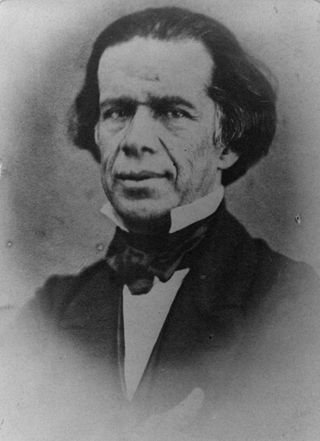
Melchor Ocampo was a Mexican lawyer, scientist, and politician. A mestizo and a radical liberal, he was fiercely anticlerical, perhaps an atheist, and his early writings against the Catholic Church in Mexico gained him a reputation as a leading liberal thinker. Ocampo has been considered the heir to José María Luis Mora, the premier liberal intellectual of the early republic. He served in the administration of Benito Juárez and negotiated a controversial agreement with the United States, the McLane-Ocampo Treaty. The Mexican state where his hometown of Maravatío is located was later renamed Michoacán de Ocampo in his honor.

The history of the Catholic Church in Mexico dates from the period of the Spanish conquest (1519–21) and has continued as an institution in Mexico into the twenty-first century. Catholicism is one of many major legacies from the Spanish colonial era, the others include Spanish as the nation's language, the Civil Code and Spanish colonial architecture. The Catholic Church was a privileged institution until the mid nineteenth century. It was the sole permissible church in the colonial era and into the early Mexican Republic, following independence in 1821. Following independence, it involved itself directly in politics, including in matters that did not specifically involve the Church.
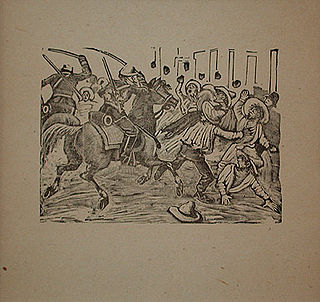
Irreligion in Mexico refers to atheism, deism, religious skepticism, secularism, and secular humanism in Mexican society, which was a confessional state after independence from Imperial Spain. The first political constitution of the Mexican United States, enacted in 1824, stipulated that Roman Catholicism was the national religion in perpetuity, and prohibited any other religion. Since 1857, however, by law, Mexico has had no official religion; as such, anti-clerical laws meant to promote a secular society, contained in the 1857 Constitution of Mexico and in the 1917 Constitution of Mexico, limited the participation in civil life of Roman Catholic organizations and allowed government intervention in religious participation in politics.

The Catholic Church in Latin America began with the Spanish colonization of the Americas and continues up to the present day.

The Political Constitution of the Mexican Republic of 1857, often called simply the Constitution of 1857, was the liberal constitution promulgated in 1857 by Constituent Congress of Mexico during the presidency of Ignacio Comonfort. Ratified on February 5, 1857, the constitution established individual rights, including universal male suffrage, and others such as freedom of speech, freedom of conscience, freedom of the press, freedom of assembly, and the right to bear arms. It also reaffirmed the abolition of slavery, debtors' prisons, and all forms of cruel and unusual punishment such as the death penalty. The constitution was designed to guarantee a limited central government by federalism and created a strong national congress, an independent judiciary, and a small executive to prevent a dictatorship. Liberal ideals meant the constitution emphasized private property of individuals and sought to abolish common ownership by corporate entities, mainly the Catholic Church and indigenous communities, incorporating the legal thrust of the Lerdo Law into the constitution.
The Liberal Party was a loosely organised political party in Mexico from 1822 to 1911. Strongly influenced by French Revolutionary thought, and the republican institutions of the United States, it championed the principles of 19th-century liberalism, and promoted republicanism, federalism, and anti-clericalism. They were opposed by, and fought several civil wars against, the Conservative Party.
The Conservative Party was a political faction in Mexico between 1823 and 1867, which became a loosely organized political party after 1849.

The Iglesias law or Ley Iglesias issued on 11 April 1857, is named after Liberal politician José María Iglesias and is one of the Reform laws of the Liberal reform in Mexico. Its aim was to regulate the cost of ecclesiastical fees for Catholic sacraments. Liberal politician Melchor Ocampo has raised this issue publicly in 1850, criticizing the Catholic Church for impoverishing Mexican peasants who could not afford the fees. The Catholic Church and its conservative supporters saw the Iglesias law as another piece of anticlerical legislation that diminished its power. Other laws had removed the church from its former role in recording births, marriages, and deaths as baptisms, wedding banns, holy matrimony, and burials in which priests were owed fees and created a civil registry. Ecclesiastical fees were a key financial support for parish priests, who were generally of modest means. Nonetheless, the church and its conservative supporters saw the Iglesias law as an attack on the church as an institution and denounced it as "illegal and immoral" and refused to comply with it. The law mandated penalties of exacting fees from poor peasants, defined as persons earning the minimum for survival. The fees were often paid by the owners of landed estates haciendas, and the costs added to a peasant's indebtedness to the owner. With mounting liberal anti-clerical legislation curtailing the power of the church and its culmination with the Constitution of 1857, conservatives revolted against the government, resulting in a three-year long civil war, the War of the Reform (1858-60).
References
- ↑ Federal Constitution of the United Mexican States (1824) Archived March 18, 2012, at the Wayback Machine Article 3.
- ↑ Chadwick, A History of Christianity (1995), pp. 264–5
- 1 2 3 4 Livingstone, Grace; foreword by Pearce, Jenny (2004). Inside Colombia: Drugs, Democracy, and War. Rutgers University Press. p. 42. ISBN 0-8135-3443-7.
